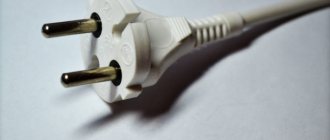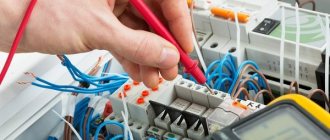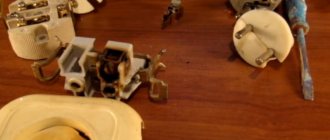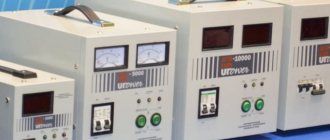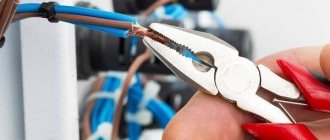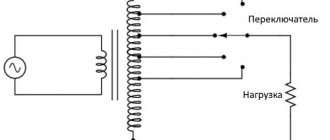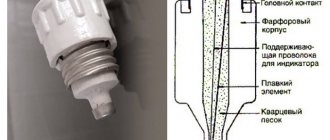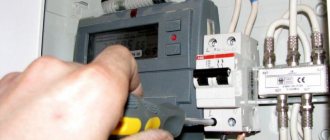electrician online Here you can ask me about electrical wiring, electrics and other subtleties of electrical installation.
Some of the outlets in my house are constantly melting and burning. At the construction market I was told that the reason was poor voltage in the network. It is necessary to install a voltage stabilizer at the entrance to the house. Is it true? Will he help?
Most likely, you were deceived; they tried to sell you a stabilizer. There is one case when low voltage in the network can cause wiring, sockets or switches to burn out - if you have a powerful electric motor connected. As the voltage decreases, the current through asynchronous and synchronous electric motors increases sharply. Wiring may be overloaded.
But this is probably not the case for you. You are writing about several sockets. I know several devices in everyday life with such electric motors: air conditioners and heat pumps. If your meltdown is not associated with these devices, then you need to pay attention to the following:
- Correspondence of the load and parameters of the socket and plug. A bad plug can also cause the outlet to overheat. Find out what current your sockets and plugs are designed for, and what current actually flows through them.
- Compliance with operating conditions. High humidity, aggressive environment or other factors can lead to oxidation of contacts, deterioration of conductivity, and overheating.
- Matching plug and socket. Plugs come with different contact diameters (even the Euro standard assumes some variation in diameters). Many manufacturers claim that their sockets are universal. But in fact, I have seen few universal sockets in my life. Usually the socket is universal in the sense that it can be installed and used with any one plug, but you cannot insert a regular plug into it after it has had a Euro in it. After using a thick plug, as a rule, with thinner ones there are problems with the quality of contact
- Quality of sockets. There are a lot of bad sockets on the market.
- Installation quality. A poor connection where the electrical cord connects to the outlet can also cause heat.
I understand that plugs can melt for the same reason?
Yes. The mechanism is the same. Poor contact between the plug and socket can cause both the plug and socket to become hot. If the wire in the plug itself is poorly connected to the contacts, then most likely only the plug will heat up.
I have twice encountered a situation where, in good plugs and sockets, the very place where the wire is connected was poorly thought out. The clamping screw was installed in such a way that the wire could not be securely clamped. As a result, I tinned the contacts in both the plug and the socket and soldered the wires.
What to do if the plug and socket get hot. What are the causes of the malfunction, problem solving, calculations of wire cross-section, all this is in this article.
The socket heats up when connecting the water heater: what to do
The cable in the apartment must have a cross-section of at least 2.5 square meters. mm for connecting to sockets, and 1.5 sq. mm for lighting.
Expert opinion
It-Technology, Electrical power and electronics specialist
Ask questions to the “Specialist for modernization of energy generation systems”
Why does the water heater socket heat up? However, such manifestations are not always characteristic of the device; often the malfunction goes unnoticed, until spontaneous combustion occurs. Ask, I'm in touch!
When you connect the plug to the socket, it heats up: probable causes of the malfunction
To choose the right thermostat for you, you should understand what types of devices there are and how they differ.
Classification of temperature-regulating devices:
- stationary: mounted in the wall, connected to the wiring;
- portable, installed in an outlet (this is what we are talking about in the article)
- thermostats in a socket with a remote sensor: such a sensor is located at the end of the cable and connected to the regulator, the cable length ranges from 10 cm to 3 m;
- thermostats with built-in sensor
- mechanical (the simplest and cheapest models);
- electronic (work is based on an electronic circuit);
- GSM-controlled (you can control them from anywhere in the city);
- Wi-Fi adjustable (can be controlled via SMS, calls and via the Internet via Wi-Fi)
Plug compatibility
When turning on various equipment, you need to remember that the plug must match the outlet. Under no circumstances should you put a Soviet plug into a Euro socket. Because heating will occur due to weak contacts inside the socket.
Frequent use of the socket also leads to the fact that the connectors cannot securely fix the electrodes.
Carrying nuances
An extension cord is also one of the devices whose cord heats up when connecting various types of equipment. It is not recommended to use extension cords because today the market is overflowing with low-quality products from China. Fires often occur due to the use of cheap fakes. There have been cases in which the extension cord simply melted when the washing machine was turned on. Therefore, take your choice of extension cord seriously to avoid any trouble.
A quality carrier can also get hot if it's on a reel. This happens because the wound wire heats up faster due to the appearance of inductance. To prevent this from happening when connecting powerful equipment, the coil is unwound.
It is better to use copper wire for wiring. Since aluminum is a plastic material and will slip out of the clamps over time. And poor contact, as always, leads to heating. If your washing machine is broken, then the best solution is to call a washing machine repairman to your home.
In this short article we will tell you about the main reasons for the lack of spin in a washing machine, as well as methods for eliminating this problem.
If the drum in your washing machine suddenly stops, do not panic. Not in all cases this indicates a breakdown in the equipment. Perhaps the reason was the usual overload of the machine. But there are still more serious reasons. Until they are clarified, it is not recommended to use the machine.
The first warning signs are that the plug heats up when in contact with the socket
What kind of lighting do you prefer?
Built-in Chandelier
The number of electrically powered equipment is increasing every year. At the same time, the risk of spontaneous combustion increases if the socket or wiring is installed incorrectly. Heating of the socket when an electrical appliance is turned on is the first signal of a malfunction.
The quick-release contact device - a plug - is simple and reliable. However, in some situations, malfunctions occur that can have negative consequences for the home. More often, the owner of the premises has to find out the reason why the plug of the device begins to heat up in the socket. Here you cannot delay in diagnosing and solving the problem.
Expert opinion
It-Technology, Electrical power and electronics specialist
Ask questions to the “Specialist for modernization of energy generation systems”
More than 15 reasons why the plug in the socket gets hot - All about electrics, equipment and technology The socket gets hot when a certain plug is turned on, but when another plug is turned on, this socket does not heat up, and the load is the same on both plugs. Ask, I'm in touch!
Why does the plug in the socket get hot: causes and troubleshooting
Modern technology is found at work, in public places, and at home. However, no matter what new devices and their modifications manufacturers produce, the devices work in the old proven combination: plug (plug) and socket.
The quick release contact device is simple and reliable, but malfunctions sometimes occur. Most often you have to find out the reason why the plug in the socket gets hot.
Reasons related to the fork
Common reasons why the plug in the socket heats up:
- Poor contact between socket and plug. The connection must be without gaps. The diameters of the plug legs and the socket holes must match. To check, slightly rock the inserted plug. If there is noticeable play, the socket must be replaced.
- The use of tees and adapters that may not be designed for such a load. The parameters are clarified with the seller or in the documents. For security reasons, it is better not to use “intermediaries” to connect powerful devices.
- Connecting equipment with plug contacts of different diameters to the socket, for example, a water heater and a hair dryer.
Briefly about electrical safety
If, when operating electrical appliances, the socket sparks when the plug is inserted or it heats up, you must do the following:
- disconnect consumers from the problematic outlet and protect it from use;
- if smoke appears from the contact device, it is necessary to turn off the corresponding bag on the distribution panel;
- exclude the inclusion of an electrical appliance whose plug heats up;
- limit the load on the outlet into which the device with the heating plug was plugged in;
- seek professional advice and diagnostics if your own skills and experience do not allow you to solve the problem.
Why does the wire in electrical appliances and extension cords get hot?
Heating of the wire in electrical appliances is caused by a disproportionate ratio of the cross-section of the wire and the strength of the current that flows through it. If the wire is thin and the appliance is powerful, for example an electric kettle or electric heater, the thin wires will heat up. The same thing happens if a device with a cable of sufficient diameter is connected to an outlet using a household extension cord.
The socket on the washing machine gets hot
If the outlet into which the washing machine is connected heats up, this phenomenon may be caused by the following reasons:
- Disproportionate power of the machine connected to the outlet - on the body of the outlet it is indicated what power it is designed for. If the numbers don't match, it will inevitably cause overheating.
- Poor contact between the plug and the socket is observed when connecting a Soviet-style plug to a European socket. The electrodes of the Soviet plug are a millimeter thinner, and therefore the contact density is less.
- The socket itself is faulty. Visually it can be diagnosed by the presence of cracks and melted areas.
- Weak socket contact blades. Due to careless use, the clamps may become loose.
When you connect the plug to the socket, it heats up: probable causes of the malfunction
Faulty plug
However, such manifestations are not always characteristic of the device; often the malfunction goes unnoticed, until spontaneous combustion occurs. Therefore, timely detection of plug failure is the key to safety in the home.
You can quickly determine what is faulty – the electrical socket or the plug itself – using a simple experiment:
- Initially turn on the device whose plug heats up in a specific outlet.
- Test the same outlet with other electrical appliances.
- If only one device in the plug heats up, while the others are working properly, then the problem is in the plug. If the plugs connected from the appliances to the socket do not work properly and heat up, the reason is in the wiring of the room or in the socket.
- improper operation of electrical devices;
- contact burnout;
- high load (as a rule, a characteristic feature for carriers and water heaters);
- incorrect cross-section of the wire if we are talking about a DIY extension cord;
- sudden surges in the network that led to a malfunction;
- low-quality device, materials (cheap plugs from China) that were used independently or by the manufacturer.
Socket failure
If the reason for the heating of the appliance plug is a malfunction of the socket, then when the device is plugged into this socket, it will overheat. Fault detection options:
- Visual inspection: external plastic defects, melting, heating - the result of a malfunction.
- Testing an electrical device by plugging it into a given connector. If the plug glows and the plug becomes hot only in this place, the cause of the breakdown is in the socket.
- The load current is higher than the declared capabilities of both equipment and wiring. The result is increased load, overheating.
- Violation of conductor insulation. Failure to comply with the device installation technology is a common and probable cause of overheating.
- Problems with contacts - oxidation or weakening. The solution to the problem is to strip and tighten the contacts, and further isolate them.
- Loose contact systems are also a common cause of malfunctions. Incorrect operation, pulling out plugs of electrical devices with sudden movements from a tight socket entails negative consequences.
Heating due to wiring
- High load on wiring. A common cause is in old panel houses with aluminum wiring.
- Small wire cross-section.
- Incorrect cable routing.
- The service life has expired.
- Improper insertion of copper wiring from old aluminum wiring.
Solving problems with a collapsible fork
A removable fork can usually be repaired. To eliminate the malfunction, initially the wire is disconnected from the device, then the bolts located either in the center or on the sides of the plug are unscrewed
Expert opinion
It-Technology, Electrical power and electronics specialist
Ask questions to the “Specialist for modernization of energy generation systems”
The socket is heating up - what to do? Most likely, the water heater was installed incorrectly, and either the socket plug wire or the contact clamp must be replaced. Ask, I'm in touch!
Poor tightening of screws in the socket
As a rule, the main cause of this type of malfunction is weak electrical contact at the points where the cable cores are connected to the socket terminals. Before carrying out repairs, it is necessary to remove the voltage from the supply line or turn off the entire apartment. Then you should remove the plastic cover of the socket: it is secured with one or two small bolts. The socket mechanism must be removed from the installation box. To do this, you will need to unscrew a pair of side screws that secure the metal case to the socket box, then loosen the crab clamps by releasing the two recessed bolts located on the sides of the socket mechanism. After removing the mechanism, you need to carefully inspect the connection point of the electrical wires for carbon deposits or poor tightening. The best solution would be to make the connection again, after first stripping the cable cores to a metallic shine.
Why does the plug from the extension cord in the socket heat up when the water heater is turned on?
- Find out the diameter of the core, for example, using a caliper. Let's say the wire is aluminum, thickness - 2.3 mm.
- The cross section is found by the formula: S=0.785*D². S - cross-section, D - diameter, 0.785 - coefficient obtained by dividing the TT value (grounding system) by 4. That is, S = 0.785 * 2.3² = 4.15 mm.
- Now the obtained value must be compared with those given in Table 1. These are standards for domestic or industrial conditions, depending on voltage. Let's take a cable used at home.
- For 4.15 mm, the exact value of current and power was not found in Table 1; you will have to calculate it. You need to find out the specific values per 1 mm². The cross section is between 4 and 6 mm. Therefore, the specific current (I) and power (N) are found as the difference between the maximum and minimum values in this interval. The latter can be viewed in the tables. The resulting figure is divided by the difference in the sections of the interval. That is, specific I=(36-28)/(6-4)=4 A/mm², specific N=(7.9-6.1)/(6-4)=0.9 W/mm².
- Specific parameters are multiplied by the difference between the found section and the minimum tabulated value of the interval. The resulting figure is added to the minimum current or power of the interval. The required I=(4.15-4)*4+28=28.6 A, N=(4.15-4)*0.9+6.1=6.24 W.
Eliminate Heat
Before you begin to troubleshoot any problems associated with electrical appliances, you must first stop the current supply to them. To achieve this, you need to turn off the machine, or unscrew the plugs on the electrical panel, after which the cover is removed from the socket, which is secured with a screw in the central part of its body.
If it is noticeable that the contact wires have been exposed to high temperatures, then this is the reason for the heating of the socket. To bring them back to normal, you need to completely remove the socket from its socket, after loosening the screws that secured it. After this, clean the contacts and place them back into the contact clamps, properly tightening the mounting screws. Then the socket is assembled and installed in its place.
If the reason is not in the contacts, but in loose connectors into which the plug electrodes fit, then they are simply tightened with pliers and the repair can be considered complete.
When cracks or even traces of exposure to high temperatures are found on the socket body, the socket cannot be used. It must be replaced. The socket is also replaced if there are no springs in it.
The next step is to check the plug. Forks are available in two types: collapsible and monolithic. Inspection is possible only with a collapsible fork. To do this, you need to disassemble it by unscrewing the screw fastening in the center of the case and inspect the wires inside, which pass inside. Melted insulation indicates that the contact in this place is weakened.
This section of the wire is removed, after which the insulation is removed from the undamaged section of the wire, and it is connected to the electrode using a screw.
In order to notice in time when it is necessary to repair a socket or plug, you need to pay attention to their temperature; it is best to do this every time the plug is removed from the socket.
Socket failure
If the check shows that the plug is working, you need to make sure that the socket is working properly. A device with a known working plug is inserted into the outlet. After turning on, you need to wait 5 - 15 minutes.
- The plug, socket, or both elements heat up. The reason is the socket.
- None of the contact surfaces got hot. A mistake was made, you need to repeat the check from the very beginning: from examining the fork.
The socket may have unsuitable characteristics. If a boiler is connected, the device must be able to withstand at least 16 A. If the socket lights up or there are other signs of overheating, it is likely that the cause is low readings. The socket was working at its maximum capacity.
Malfunctions and their elimination
If the socket is faulty, it can be replaced, disassembled and repaired.
- The terminal does not clamp the wire well enough. The bolt should be tightened until it stops.
- The spring does not function well: it is damaged, holds weakly or is missing. You need to tighten it/install a new one.
- The brass plates are deformed and do not provide a tight connection. You can bend it and put it in the correct position.
- The tip of the wire is damaged and the insulation has melted. A new contact is made: the damaged area is cut off, the insulation is removed by about 7 mm, and reinserted into the terminal.
- Sometimes the socket melts. In this case, the body and internal elements made of plastic (carbolite) are damaged. Brass plates can change position and lose contact. The socket is replaced with a new one.
After installing and connecting the water heater, did you notice that the outlet is heating up? Why is this happening? To understand the reasons, you need to figure out how the wiring is organized, how many devices are working simultaneously, and whether everything is connected according to the rules. Read our publication to find out what to do about the malfunction.
While your water heater is running, have you touched the cable or plug and felt it warm? This is normal if the network devices are selected in accordance with the power of the boiler. The electrical conductor has resistance, so it heats up.
However, everything should be in moderation. If you notice that the socket and plug are overheating, you need to find the cause of the problem.
Huge pressure. Storage boilers have a power of 1.2 to 3 kW. The network load is about 12 Amperes. Therefore, it is forbidden to connect several devices at the same time, because then the load may exceed 30 A and a fire will occur.
The power of flow heaters starts from 6 kW and can reach 30 kW. You can't do without wiring with a thick cross-section. In such cases, special wiring of at least 4-6 mm is laid.
The device must be grounded and an RCD must be installed.
- Using an extension cord, adapter, tee. For a powerful boiler, it is important to organize a high-quality, moisture-resistant socket with grounding. It is not advisable to use transition means, or to connect several devices into one tee. It's not surprising that it will start to heat up.
- Malfunction of plugs. In this case, only the fork will heat up. To make sure that this is really the reason, connect the equipment to a different outlet. After 10-15 minutes, try the fork. Hot? Then you need to replace the plug or the entire part.
- Loose insertion of the fork. The contacts have become loose, the bolts may have become loose, the connections have become loose. This happens when several devices with different plug sizes are connected to the same network. For example, on an electric kettle they are wide, but on a Thermex water heater they are narrow. When you connect it, play is formed and heating occurs.
- The power of the socket does not correspond to the parameters of the equipment. It is important to select components in accordance with the boiler parameters specified in the instructions. In this case, the product cannot withstand the voltage, the panel and the plug wire melt.
Expert opinion
It-Technology, Electrical power and electronics specialist
Ask questions to the “Specialist for modernization of energy generation systems”
Solving problems with a collapsible plug That is, when a comfortable temperature is reached in the room, the heater has to be turned off, and when it becomes cool again, turn it on. Ask, I'm in touch!
The wire (plug) of the washing machine gets hot
The situation is this: it recently started to overheat completely. The car is old, it’s already 9 years old. LG. It was initially connected directly to the outlet without a pilot. It worked without overheating. After renovating the kitchen, I rearranged it. And it was impossible to connect to that outlet because the wire couldn’t reach it. I bought a temporary extension cord with a fuse and connected it through it. It worked for 3 months without problems. A few days ago the wire started to overheat. The fuse pops out and the machine turns off. I tried to plug the extension cord into another outlet and it also turned off. I connected another extension cord, the wire of the machine and the extension cord heat up. What could be the problem. Does it make sense to repair? Maybe it's easier to buy a new one? The heating element had already broken and was replaced. Now the wire. Please give me some advice. I don't understand anything about electricity((((
Try moving it closer to the outlet and turning it on without extension cords. If it doesn’t help, repair the washing machine.
MarinaK wrote: I temporarily bought an extension cord with a fuse and connected it through it.
Typically, extension cords come with a wire with a cross-section of 1.5 square (1.5 sq. mm), for SM, PMM, irons, etc. this is not enough. You need to take an extension cord with a cross-section of at least 2.5 square.
Gray wrote: . If it doesn’t help, repair the washing machine.
IMHO, the plug may be faulty. If it gets hot in a normal outlet, cut off the plug and install a new one. //// Or will we change the car if the ashtray is full?
By the way, it is not recommended to use extension cords in your home all the time, as well as tees. But who follows this?
MarinaK wrote: I connected another extension cord, the wire of the machine and the extension cord heat up
They probably bought it cheaper, with a thin cord. Look for a good one with a thick cord that says 3.5 KW, or 10 Amps - minimum. What area do you live in?
MarinaK, no. go there while the weather is still bad
Easily. At the same time, the plug is part of the washing machine, just as the ashtray is part of the car.
BV wrote: Or will we change the car if the ashtray is full?
I suggested repairing, not changing)))
Chepik wrote: Usually extension cords come with a wire with a cross-section of 1.5 square (1.5 sq. mm), for SM, PMM, irons, etc. this is not enough.
Chepik wrote: You need to take an extension cord with a cross-section of at least 2.5 square.
It’s impossible to find such people, they simply don’t exist.
Chepik wrote: Usually extension cords come with a wire with a cross-section of 1.5 square (1.5 sq. mm), for SM, PMM, irons, etc. this is not enough.
Chepik wrote: You need to take an extension cord with a cross-section of at least 2.5 square.
It’s impossible to find such people, they simply don’t exist.
BV, it’s possible to find (long construction carriers, say), just don’t))
Topikstarter has two options - either the heating element died again (from the probe to the body), or the extension cord is weak.
vlad178 wrote: BV, it’s possible to find (long construction carriers, let’s say), just don’t))
vlad178 wrote: BV, it’s possible to find (long construction carriers, let’s say), just don’t))
B.V.
But this no longer applies to the topicstarter problem.
tyuk, Yes, we convinced you, it’s really 3x2.5.
But the thickness of the cord in the photo is confusing, and China is the country of production*
The lady clearly wrote, “the wire of the machine and the extension cord heat up” at the very beginning. So the conclusion is simple, the load has increased. The car is old, the engine may be jammed or the heating element may be shortened.
shuryaev wrote: So the conclusion is simple, the load has increased. The car is old, the engine may be jammed or the heating element may be shortened.
This is called blurting out without thinking. If the engine jammed so much that the washing machine cord would heat up, then:
- There would be noticeable engine noise
- If the bearing jammed, there would be a squeal and the bearing would quickly melt
If the heating element “shortened up” an extra kilowatt, it would have blown out long ago (unless, of course, there is a heating element without a built-in fuse) or would have died quietly if there was a fuse.
shuryaev wrote: So the conclusion is simple, the load has increased. The car is old, the engine may be jammed or the heating element may be shortened.
This is called blurting out without thinking. If the engine jammed so much that the washing machine cord would heat up, then:
- There would be noticeable engine noise
- If the bearing jammed, there would be a squeal and the bearing would quickly melt
Several reasons why the mechanical mod and electric motor heat up
Mechmod is a button on an electronic cigarette, consisting of a housing for batteries with contacts. Usually, owners monitor the condition of the cigarette, so if it gets too hot, they try to fix the problem right away.
- Incorrect operation of the device, frequent pressing of buttons or tightening too much;
- Long service life and poor maintenance
- High battery booster with low coil resistance;
- Problems with the batteries, the contact has come loose or the board has failed.
Extreme heat from an e-cigarette can cause the batteries to explode. Therefore, it is necessary to carry out the vaping process correctly and constantly monitor the condition of the mechanical mod.
Due to increased heating, the electric motor in the car burns. The culprit may be a failed bearing when the motor does not reach the required frequency.
Increased or decreased voltage in the network, short circuit of the turns in the stator coil can lead to overheating and the appearance of smoke. Sparking and strong heating occur when the brushes are worn out or their sizes do not match.
Expert opinion
It-Technology, Electrical power and electronics specialist
Ask questions to the “Specialist for modernization of energy generation systems”
Problems in contact connectors: why does a plug melt in a socket? Heating of electrical wires is a dangerous phenomenon, which can cause melting of the protective insulation and cause the electrical wiring to ignite. Ask, I'm in touch!
What is heating up and why?
The first step is to find out what exactly is heating up: the plug or the socket. The “culprit” cannot be determined by eye, so you should conduct a quick test: turn on the washing machine to another electrical outlet. If the situation repeats itself and the end of the power cord is hot again, then the problem is in the plug. The washing machine power cord heats up for several reasons:
- poor contact between the wiring and the contacts of the mechanism (the washing machine plugs are non-separable, so you will have to replace the entire cord or plug);
- factory defect - a malfunction of an initially low-quality plug may appear over time;
- oxidation of contacts and, as a result, disruption of current conductivity (stripping of cores due to the non-demountable structure is impossible, so replacement is indicated).
It’s another matter if it’s not the plastic body of the plug that heats up, but its outer contacts. Then the likely reason lies in the socket - its holes do not fit the plug pins. A loose “girth” disrupts current conductivity, causing the temperature of the elements to rise. Most likely, the receiving “legs” were deformed or were initially out of size. Attempts to straighten and adjust the structure are unsafe; it is better not to risk it and replace the electrical point completely.
Modern washing machines are equipped with non-removable plugs - if they break, you will have to replace the plug or the entire power cord.
When looking for a replacement cord, plug or socket, it is recommended not to skimp. First, choose original spare parts based on the serial number of the washing machine. Secondly, buy products from trusted companies. Otherwise, some time after the replacement, you will have to figure out again what to do when the contacts heat up.
If the plug from the washing machine melts in the bathroom, what should you do?
Another common problem with heating plugs is that they become heated in the bathroom. As a rule, the fork is heated during intensive operation of the washing machine - when the water is heated by the TEN. It is important to pay attention to a number of reasons:
- Quality socket and plug.
- The socket is moisture protected.
- Oxidation of wires both in the socket and in the plug.
- Washing machine wire cross section.
- Specific load on wiring in the apartment as a whole. In some cases, even old wiring can handle the load. It is just important not to turn on all household appliances in the house at once.
If a simple socket without moisture protection was installed, then over time there is the prospect of oxidation, which leads to heating of the equipment. You should also clean forks or carriers if they are used in the bathroom: dust and dirt are undesirable companions in the operation of the washing machine.
Heating of a plug or socket in an apartment is a common problem that requires an immediate solution. Old wiring and low-quality electrical appliances, as practice shows, are the most common causes of this situation. However, you can deal with this problem yourself, knowing how and why the outlet in the house gets hot.
Expert opinion
It-Technology, Electrical power and electronics specialist
Ask questions to the “Specialist for modernization of energy generation systems”
Solving problems with a collapsible fork, the calculation formula is S 0.785 D, where S is the cross-section, and D is the diameter, respectively, 0.785 is a coefficient figure obtained by dividing TT earth by the number 4;. Ask, I'm in touch!
Why does the washing machine get hot?
Regardless of the model manufacturer, be it LG or Indesit, the washing machine may break down one day. There are different breakdowns, for example, the machine knocks out the plugs, does not heat the water, the device itself gets hot. In any such situation, the owner of the machine must prevent breakdown. Let's take a closer look at the reasons why the washing machine gets very hot.
The washing machine is broken
How to check?
Before you decide why the washing machine is heating up, you need to make sure of this. But how to do that?
- Place your hand on the body of the washing machine.
- Touch (very carefully) the glass part of the device door.
- Check the plug and wire, because they can also overheat, which provokes the final breakdown of the device.
Temperature
Sometimes it all comes down to the temperature of the water at which the clothes are washed. After all, one mode provides 30-40°, and the other – up to 95°. In the latter case, the Bosch Max 4, Indesit or LG machine actually heats up noticeably along with the water.
Opening the machine door
If the water does not heat up, then the body of the technical device will not change its temperature at all. Then we can safely say that there are problems with heating the liquid.
Why does the water in the washing machine not heat up?
- Incorrect connection (unauthorized discharge of liquid into the sewer).
- Wrong choice of program due to inattention.
- The heating element (heater) burned out. This could happen due to age, manufacturing defects, short circuit.
- The temperature control sensor is broken.
- The programmer is faulty (microcracks on the track, broken firmware).
If the problem is not the temperature, but the machine gets very hot immediately after purchase, it makes sense to take it under warranty and have it checked or call a repairman to your home. Sometimes the problem is a low-quality product.
The heating element has deteriorated
The plug gets hot
When it seems that the washing machine is heating up, you need to disconnect it from the power supply. This is very easy to do if you unplug the plug from the socket. What if the owner of the device noticed that not only the top case, but also the wire got hot?
Why does the plug of the washing machine get hot along with the wire?
- Prohibited load. Companies that produce low-quality products provide a minimum safety margin due to load. In such a situation, you will have to change the plug and wire.
- Faulty socket. You should pay attention to the temperature of not only the plug, but also the socket; in this case, the plastic may become charred, and its fastening will noticeably weaken.
- Wiring. Also, the Soviet aluminum cable cannot withstand modern loads, since now a washing machine, TV, hair dryer, iron, computer and other appliances are working simultaneously in the apartment. The wiring simply cannot cope with such a load, so for safety reasons (possible short circuit and fire) it is best to replace it.
Electric motor failure
The engine stops working for a variety of reasons. For example, due to the drum of an LG or Indesit washing machine being overloaded with clothes, a change in its power, worn out or “non-original” brushes. The panel heats up - this is why the motor becomes faulty.
Drum Inspection
If the washing machine engine is heating up, you can smell the wife's characteristic smell of rubber or plastic. Even if the wires do not burn, overheating can be easily checked by lightly touching the motor.
The engine is not repaired; usually it is immediately replaced with a new one. Don't wait until the washing machine starts smoking. In the event that the owner of a piece of equipment discovers that it is heating up, you should call a technician or, if you have the skills, carefully inspect the engine yourself.
Why else do LG or Bosch Max 4 devices overheat:
- short circuit in the control board;
- object hitting heater or motor;
- the contact of the tubular electric heater is burnt;
- short circuit;
- The thermostat has failed.
What to do?
The first step is to carefully inspect the washing machine and turn off the power by disconnecting the plug from the outlet. Now you need to determine the cause of the breakdown, without which the equipment cannot be repaired.
It’s better not to do this yourself, but to trust professionals in their field, especially when:
- the case gets very hot;
- heating temperature is very high;
- The glass of the washing machine is heating up.
After diagnosing, repairing or replacing a faulty part, the technical product will work as before.
Call the master
Selecting parts yourself sometimes just means wasting money. A beginner cannot always figure out which material is best to choose a part from, which in the end simply won’t fit the machine.
If the washing machine is heating up, there is no need to wait until it smokes. There are many reasons why you may notice that the panel on top or the glass is heated. Any minor breakdown can completely disable the device.
Source: https://1stiralnaya.ru/neispravnosti/greetsya-stiralnaya
Socket failure
- Option number 1 . Core diameter. This measurement is carried out by measuring with a caliper. Example:
- aluminum wire, 2.3 mm thick;
- calculation formula: S=0.785 * D², where “S” is the cross-section and “D” is the diameter, respectively, 0.785 is the coefficient figure obtained by dividing “TT” (ground) by the number 4;
- according to calculations, “S” is equal to 4.15 mm (0.785 * 2.3²).
- the resulting number (value) is compared with the given data from the table. (HERE IS A TABLE FROM THE INTERNET, I WILL FIND IT MYSELF)
- Option #2. If the obtained value is not in the table, the calculation is carried out differently. To determine the specific value per 1 mm², it is necessary to find the value for a cross section in the range between 4 and 6 mm: specific current strength - “I”, power - “N” - as the difference between max. and min. values in this interval. The value is divided by the difference in the sections of the interval: “I”=(36-28)/(6-4)=4 A/mm², “N”=(7.9-6.1)/(6-4)=0, 9 W/mm². We multiply these parameters by the difference in cross-section and min. table value of the interval, a number is obtained that is added to the min. the magnitude of the power of the interval (current strength). The required “I” is:
- (4.15-4)*4+28=28.6 A;
- "N"=(4.15-4)*0.9+6.1= 6.24 (W).
Causes
There are some reasons why the cable overheats:
- The incorrect cross-section of the wiring is not able to withstand the load, so the washing machine cord heats up.
- The wiring in the house is incorrectly installed, which is why overheating occurs.
- The connections are made poorly.
- The cable used is of poor quality.
If you notice that the cord of your washing machine or other equipment is heating up, it is advisable to immediately eliminate the problem. To do this, we determine how heating occurs in a specific section of the wire or whether it is completely heated. The washing machine plug often gets hot when power is supplied from the mains. Heating occurs due to poor contact between the outlet terminals and the power cord. Therefore, the terminals heat up, heating up the electrical plug itself.
Another reason for such a breakdown is a low-current outlet, for example, 10 amperes. Since there are such devices with increased power: stoves, boilers, heaters, some types of kettles. Their normal operation occurs when plugged into a 16-amp outlet. Also, these characteristics apply to the panel itself in the house. Without taking these nuances into account, heating can lead to melting of the socket, which in turn can cause a short circuit.
Problems also occur when there is poor contact between the plug of electrical appliances or at the other end of the wire, where it connects directly to the device's block. When the plug heats up, you need to disassemble it and make sure the connections are correct and secure. If a malfunction is detected, remove them. The washing machine wire gets hot, check its connection to the washing machine itself.
It also happens that everything seems to be in order, but the wire still heats up evenly. In this case, most likely the reason is that during production the manufacturers themselves saved on it by reducing its cross-section. Thus, the entire wire will heat up. If the power of the electrical appliance is 4.5 kW, you will need a wire with a cross-section of at least 2.5. In this case, you will need to change the washing machine cord to a suitable one.
Load determination using wire cross-section
The conductor area needs to be known. This way the wiring capabilities are determined and the load is controlled.
To determine how much a contact pair can withstand, it is necessary to take measurements:
- Find out the diameter of the core, for example, using a caliper. Let's say the wire is aluminum, thickness - 2.3 mm.
- The cross section is found by the formula: S=0.785*D². S - cross-section, D - diameter, 0.785 - coefficient obtained by dividing the TT value (grounding system) by 4. That is, S = 0.785 * 2.3² = 4.15 mm.
- Now the obtained value must be compared with those given in Table 1. These are standards for domestic or industrial conditions, depending on voltage. Let's take a cable used at home.
- For 4.15 mm, the exact value of current and power was not found in Table 1; you will have to calculate it. You need to find out the specific values per 1 mm². The cross section is between 4 and 6 mm. Therefore, the specific current (I) and power (N) are found as the difference between the maximum and minimum values in this interval. The latter can be viewed in the tables. The resulting figure is divided by the difference in the sections of the interval. That is, specific I=(36-28)/(6-4)=4 A/mm², specific N=(7.9-6.1)/(6-4)=0.9 W/mm².
- Specific parameters are multiplied by the difference between the found section and the minimum tabulated value of the interval. The resulting figure is added to the minimum current or power of the interval. The required I=(4.15-4)*4+28=28.6 A, N=(4.15-4)*0.9+6.1=6.24 W.
The found values must be compared with those specified in the instructions for the devices being switched on. If the required parameters are greater than those found, the wiring cannot cope and causes heating. It is better to choose a high-quality copper cable with a thickness of 4–6 mm.
Knowing how to fix minor breakdowns will not be superfluous in the household. If you understand the reasons for the violation, you can not aggravate the situation, but correct it in time.
Expert opinion
It-Technology, Electrical power and electronics specialist
Ask questions to the “Specialist for modernization of energy generation systems”
Solving problems with a collapsible plug If the socket heats up, then you should not hope that the reason for this will simply disappear, without outside intervention. Ask, I'm in touch!
Why does the socket on the washing machine get hot?
» Sockets » Why does the socket on the washing machine get hot 08/31.
2015
- 1 What is the reason
- 2 The plug must be compatible
- 3 Eliminate heat
In order to prevent short circuits, burnt wires and thereby prevent damage to household electrical appliances, it is necessary to regularly check the condition of the sockets. After all, it is always easier and cheaper to prevent a minor breakdown than to later pay for your sluggishness not only with money, but possibly with your health.
If the outlet is heating up, then you should not hope that the reason for this will simply disappear, without outside intervention.
Heating of the outlet can be caused by various reasons, including:
- Excessive power of electrical appliances connected to the outlet.
- Unstable contact of the plug inside the socket.
- Malfunction of the connectors inside the socket.
- The contact of the socket clamp is not tight enough.
What is the reason
In most cases, sockets burn out due to multiple excess power of various electrical appliances that are connected to it.
You should know that on the body of any outlet there is relevant information in numbers that helps solve the problem before it occurs.
You just need to know the power of electrical appliances connected to the network and compare these numbers with those indicated on the outlet.
If several devices are simultaneously connected to one outlet, this will certainly cause an overload, the resistance will rise and the outlet will begin to heat up quickly. To prevent heating of both the plug and the outlet itself, it is important to control the extent to which power sources are loaded.
Often, the reason for an insecure connection between the socket and the plug is the unsatisfactory fixation of the plug with the connectors inside the socket. Old-style plugs from the times of the USSR are still very common, but their electrodes are almost a millimeter thinner than the electrodes of modern sockets, and the electrodes themselves are located at the same distance on both types of sockets.
The plug must be compatible
You need to be careful and not try to connect a Soviet plug into a modern socket: this will certainly cause it to heat up, due to the guaranteed weak contact with the connectors inside the socket.
If the socket is subjected to frequent mechanical stress, that is, the plug is often removed and inserted, then the socket connectors quickly fail and cannot sufficiently fix the electrodes. This also causes the outlet to heat up.
Probably the best wire material to use for wiring is copper rather than aluminum. And the point here is not electrical conductivity or resistance difference. The fact is that aluminum has one drawback: it is very plastic and, over time, tends to leak out from under the contact clamps. This weakens the screw clamp and inevitably causes the socket to heat up.
Useful video
- Incorrect operation of the device, frequent pressing of buttons or tightening too much;
- Long service life and poor maintenance
- High battery booster with low coil resistance;
- Problems with the batteries, the contact has come loose or the board has failed.
Useful tips Connection diagrams Principles of operation of devices Main concepts Meters from Energomer Precautions Incandescent lamps Video instructions for the master Testing with a multimeter
Is the outlet really at fault?
According to statistics, the majority of fires are caused by problems with electrical wiring. Broken insulation, incorrectly calculated load, ignoring safety precautions, faulty equipment - all this creates an emergency situation. To avoid fire, it is necessary to prepare the line to connect the washing machine, and if alarming signs appear, begin diagnostics. Melting, smoke, burning smell, dark spots around the socket and sparking are serious reasons for checking. Having noticed such “symptoms”, you need to act:
- cut off power to the room or the entire apartment;
- make sure the power is turned off;
- start diagnostics.
When checking the electrical connection, follow safety instructions or call an electrician.
The problem does not always lie in the outlet itself. Often the culprit is the plug, whose screws fly off and the contacts become loose. Also, the cord begins to heat up if the plug is not suitable for the electrical outlet: the pins of the plug are smaller than the socket holes. It’s easy to check your guess - plug the washing machine into another outlet. If within 10 minutes the story of heating and melting repeats, then the problem has been found: the plug needs to be repaired or replaced. Local repairs are not recommended. It is safer and more reliable to replace the entire wire.
Heating due to wiring
The electrical network is able to cope normally with certain loads. For this purpose, special calculations are carried out. The cross-section of the wire is decisive.
This may not be taken into account in the following cases:
- Many houses were built in Soviet times, when electricity consumption, installed appliances and their number were different.
- Sometimes in new buildings, unscrupulous developers make such calculations incorrectly.
- In houses, people do the wiring themselves, not knowing all the rules or neglecting them, or they entrust the work to the wrong specialists.
Most buildings now use aluminum cable with a diameter of 2.5 mm or less. Such wiring can withstand a current of about 20 A, a power of approximately 4.4 W. If you simultaneously connect several powerful devices such as a washing machine to a contact pair, the normal load may be exceeded. The consequences will not be long in coming.
If the outlet gets hot and other symptoms are noticeable:
- It is advisable to find out the required parameters and replace the wiring. Copper is better.
- It is necessary to monitor the load level on the contact pair (plug, socket).
In the latter case, you need to keep in mind that the load is summed up:
- if there are many branches, but the feeding nest is the only one;
- if there are several contact pairs, but they are connected in series.
Overloaded socket
Before disassembling the heating case, be sure to think about whether you have “overloaded” the outlet. Manufacturers always prescribe at what load current the device will operate normally (for example, at a current of up to 16 Amps this is about 3 kW). Therefore, if an automatic machine has more power, it is logical that the outlet will heat up. The same effect is ensured when connecting a tee to the point and powering several electrical appliances from it at once, with a total consumption of more than 3 kW (for our example).
When the outlet does not fit the power of the machine, you must create a new point to power the washing machine.
It is ideal to allocate a separate outlet for washing equipment and equip the line with a residual current device and a stabilizer. Then there will be no problems with heating the body of the “point”.
The wire is broken or pinched
The first thing you need to check is the cord itself. When the wire is completely broken, the equipment will not work - the electricity will not “reach” the control board. It’s another matter if the cable is pinched by a heavy object, for example, if it accidentally gets under the foot of a washing machine or gets stuck in a door. Then, at the point of compression, contact will be broken, which will lead to heating of the insulation, first in the damaged area, and then along the entire length.
You cannot leave the wire in a pinched state. The insulation can break at any time, leading to a fire. It’s better not to take risks and if you suspect heating, check the cord along its entire length.
You cannot operate a washing machine with a heating wire - you need to turn off the power to the equipment and start diagnostics!
Sometimes the cord gets squeezed for a long time, for example, during transportation or installation of a washing machine. Then the insulation failure can only be detected using a multimeter. You will have to turn on the buzzer mode and ring the cable along its entire length.
Why does the socket melt?
Forum / Electrical / Why does the socket melt?
Ask a question you are interested in on our forum without registration
and you will quickly receive an answer and advice from our specialists and forum visitors! Why are we so sure of this? Because we pay them for it!
Find out details
Treff
Rating: 4
August 19, 2016at 5:56 am
I noticed that the socket into which the boiler was connected had melted a little. This boiler has been powered from this outlet for more than three years and there have been no such problems before. There is a ground connection on the shield. Why is she melting? Should I replace it or may it not be the cause?
Root
Rating: 127
August 19, 2016at 6:51 am
Oxidation of contacts or weakening of the springs pressing the contacts of the socket to the lamellas of the plug. It can be cured, but it is hardly advisable, given the high power of the consumer (boiler). Replace it so that your soul will be at peace. ps Another possible reason is that the clamping of the wires in the terminal connections of the socket has weakened.
The water heater plug is getting hot
Tighten it, and if the heating goes away, you don’t have to change the socket.
Anatoly Shabalin
Rating: 34
August 19, 2016at 7:58 am
I agree with what Root said. But it is also important what kind of outlet it is. More precisely, what load is it designed for?
And the body material. Look for one with a ceramic body. They are usually more powerful. And of course not Chinese.
vitas64
Rating: 85
August 19, 2016at 8:37 am
The socket melts because too much load is passing through it. Over time, the contact plates or springs weaken and carbon deposits form on them. The socket needs to be replaced or the contacts bent and cleaned, but I would install a two-way breaker instead of the socket.
VLAD
Rating: 67
19 August 2016at 21:15
The problem most likely was in the contact plates or springs; they weakened over time and the contact began to deteriorate. Therefore, the socket began to melt. It would be better to replace it with a new one for reliability.
